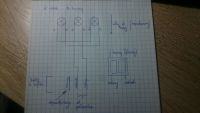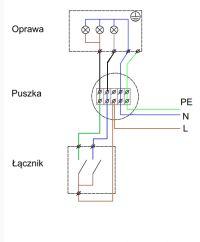Hello, I have a problem with connecting the lamp in the room. I have placed an overview of the scheme in the annex.
The problem looks as follows, I have a double switch, the light will turn on (3 bulbs) only when I turn on two buttons. Two three wires come out of the ceiling, black, blue and green. Black is insulated and not connected to anything. Blue and green, I bet that they are two phase cables from the switch. The cables are connected as in the attachment. Three blue from the lamp connected to blue from the ceiling (with a switch) and three brown from the lamp connected to the green from the ceiling (with a switch).
Is it okay to embrace that the lamp is on 2 + 1? One button for two light bulbs, one button for one?

The problem looks as follows, I have a double switch, the light will turn on (3 bulbs) only when I turn on two buttons. Two three wires come out of the ceiling, black, blue and green. Black is insulated and not connected to anything. Blue and green, I bet that they are two phase cables from the switch. The cables are connected as in the attachment. Three blue from the lamp connected to blue from the ceiling (with a switch) and three brown from the lamp connected to the green from the ceiling (with a switch).
Is it okay to embrace that the lamp is on 2 + 1? One button for two light bulbs, one button for one?





